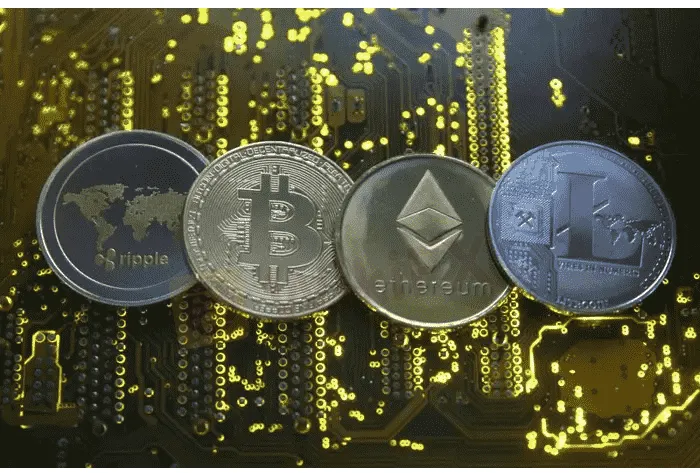简体中文
繁體中文
English
Pусский
日本語
ภาษาไทย
Tiếng Việt
Bahasa Indonesia
Español
हिन्दी
Filippiiniläinen
Français
Deutsch
Português
Türkçe
한국어
العربية
Bitcoin set for record losing streak as ‘stablecoin’ collapse crushes crypto
Abstract:Cryptocurrencies nursed large losses on Friday, with bitcoin pinned below $30,000 and set for a record losing streak as the collapse of TerraUSD, a so-called stablecoin, rippled through markets.

Crypto assets have also been swept up in broad selling of risky investments on worries about high inflation and rising interest rates. Sentiment is particularly fragile, as tokens supposed to be pegged to the dollar have faltered.
Bitcoin, the largest cryptocurrency by total market value, managed to bounce in the Asia session and traded at $30,300 at 0623 GMT, up 5%. It has staged something of a recovery from a 16-month low of around $25,400 reached on Thursday.
But it remains far below week-ago levels of around $40,000 and, unless there is a rebound in weekend trade, is headed for a record seventh consecutive weekly loss.
“I dont think the worst is over,” said Scottie Siu, investment director of Axion Global Asset Management, a Hong Kong based firm that runs a crypto index fund.
“I think there is more downside in the coming days. I think what we need to see is the open interest collapse a lot more, so the speculators are really out of it, and thats when I think the market will stabilize.”
TerraUSD (USDT) broke its 1:1 peg to the dollar this week, as its mechanism for remaining stable, using another digital token, failed under selling pressure. It last traded near 10 cents.
Tether, the biggest stablecoin and one whose developers say is backed by dollar assets, has also come under pressure and fell to 95 cents on Thursday, according to CoinMarketCap data, but was back at one dollar on Friday.
UNSTABLE
Selling has roughly halved the global market value of cryptocurrencies since November, but the drawdown has turned to panic in recent sessions with the squeeze on stablecoins.
These are tokens pegged to the value of traditional assets, often the U.S. dollar, and are the main medium for moving money between cryptocurrencies or to convert balances to fiat cash.
“Over half of all bitcoin and ether traded on exchanges are versus a stablecoin, with USDT or Tether taking the largest share,” analysts at Morgan Stanley said in a research note.
“For these types of stablecoins, the market needs to trust that the issuer holds sufficient liquid assets they would be able to sell in times of market stress.”
Tethers operating company says it has the necessary assets in Treasuries, cash, corporate bonds and other money-market products.
But Tether is likely to face further tests if traders keep selling, and analysts are concerned that stress could spill over into money markets if pressure forces more and more liquidation.
Ether, the second-largest cryptocurrency by market capitalisation, steadied near $2,000 on Friday after a drop as low as $1,700 on Thursday. Bitcoin and ether are about 60% below record peaks reached in November.
Crypto-related stocks have also copped a pounding, with shares in broker Coinbase steadying overnight but still down by half in little more than a week.
In Asia, Hong Kong-listed Huobi Technology and BC Technology Group, which operate trading platforms and other crypto services, eyed weekly drops of more than 17%.
Amid the turmoil, Nomura on Friday said it had begun offering bitcoin derivatives to clients, the latest move by a traditional financial institution into the asset class.

Disclaimer:
The views in this article only represent the author's personal views, and do not constitute investment advice on this platform. This platform does not guarantee the accuracy, completeness and timeliness of the information in the article, and will not be liable for any loss caused by the use of or reliance on the information in the article.
Read more

Technical Analysis Tools in Forex Trading
Are you aware of the technical analysis tools that greatly determine the forex market’s direction? What do these tools do and why do avid traders eye these every day? If not, then start becoming aware of these tools that greatly dictate your forex earnings over time. Without any further ado, let’s start discussing these tools and their impacts.

Top Tips to Choose the Best Forex Broker in 2025
You need a solid forex broker to make the most of the currency fluctuation. The strategies they use to take you through the ups and downs of forex trading are beyond words. While the strategies may seem solid, the eventual gains matter more. That’s where you need to take notice of the forex brokers, how they approach, their fee structure, rating, etc. To help you evaluate forex brokers better, we have this guide for you. Read it to choose the right forex broker in 2025.

Rupee Continues to Fall Under Robust Demand for US Dollar
Rupee continued to fall for the sixth time in seven trading sessions on Wednesday (June 4, 2025) under robust demand for the US dollar. The Indian National Rupee slipped past 86 to the US dollar. The fall is attributable to the bullish bets made by traders for the USD. The day saw the rupee falling to 86.025 before recovering to end the day at 85.90. It was 0.4% lower than the previous day's close.

Blockchain Decentralization: Empowering a Trustless Future
In recent years, blockchain technology has rapidly evolved from a niche innovation behind Bitcoin into a transformative force across industries. At its core, blockchain decentralization refers to the distribution of authority and decision-making away from a central entity and into the hands of a distributed network of participants. This shift redefines how data is stored and verified and paves the way for trustless, transparent, and resilient systems that challenge traditional centralized models.
WikiFX Broker
Latest News
He Thought He Earned RM4 Million, But It Was All a Scam
CryptoCurrency Regulations in India 2025 – Key Things You Should Know
OctaFX Back in News: ED Attaches Assets Worth INR 134 Cr in Forex Scam Case
Trump inaugural impersonators scammed donors out of crypto, feds say
Ethereum is powering Wall Street's future. The crypto scene at Cannes shows how far it's come
Forex Hedging: Is It a Trader’s Safety Net or Just an Illusion?
US debt is now $37trn – should we be worried?
OPEC+ members agree larger-than-expected oil production hike in August
Dukascopy Ends EOS/USD Trading Amid Liquidity Issues
FIBO Group MT5 Cent Account with Ultra-Leverage up to 1:5000 for Beginners
Currency Calculator


